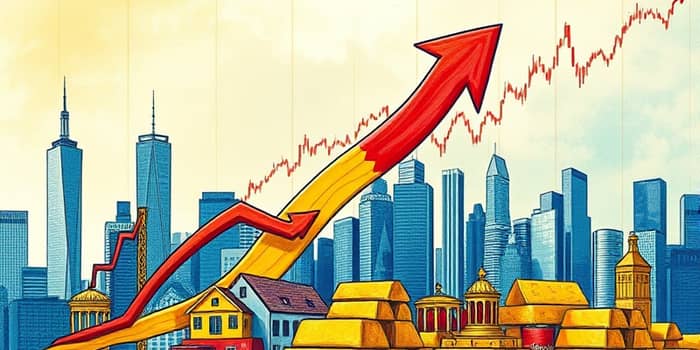In 2025, inflation remains a central concern for investors worldwide. Understanding its dynamics is crucial for portfolio resilience and long-term growth. This article unpacks the latest data, trends, and strategies to help you navigate a persistently challenging environment.
Whether you are building a retirement plan or managing wealth across generations, recognizing how inflation shapes market returns and investment choices can spell the difference between achieving your goals or falling short.
Defining Inflation and Its Economic Context
Inflation refers to the general rise in prices of goods and services over time, reducing the purchasing power of money. The most widely tracked gauge is the Consumer Price Index (CPI), which measures changes in prices paid by urban consumers for a standardized basket of items.
The Federal Reserve’s preferred measure, the Personal Consumption Expenditures (PCE) Price Index, often shows slightly different readings due to its broader methodology. As of February 2025, CPI data reveal a 0.5% rise in January and a 3.0% year-over-year gain, while core PCE stands at 2.8%. These figures, though lower than 2022–2023 peaks, remain persistent above historical averages, indicating a sustained backdrop of upward price pressure.
Tracking both CPI and PCE provides a more complete picture. CPI emphasizes out-of-pocket consumer expenses, while PCE captures business payments for consumer goods and services. Together, they guide central banks in calibrating policy.
Macroeconomic Trends Driving Inflation
Several forces converge to shape inflation in 2025. Robust wage growth—averaging near 4.2% annual gains—has supported higher consumer spending, keeping demand elevated.
Energy price fluctuations and supply constraints also play a pivotal role. Geopolitical events, from shipping disruptions to regional conflicts, intermittently drive oil and gas costs higher, which then ripple through transportation and manufacturing.
Tariffs and ongoing trade tensions impose additional cost burdens on imported goods, leading businesses to pass higher prices onto consumers. This complex interplay of demand, supply, and policy highlights why inflation has moderated but not returned to pre-pandemic norms.
In response, the Federal Reserve has maintained policy rates around 4.5%. Recent Fed minutes underscore caution, noting that any premature easing could risk reigniting inflationary momentum. As a result, market expectations for rate cuts in 2025 have been scaled back significantly.
Current and Expected Inflation Rates for 2025
Analysts predict inflation will decelerate over the next quarters but remain above the long-term target. The University of Michigan’s June 2025 survey reports consumer expectations climbing to 5.1%, compared to 3.3% in January, suggesting households anticipate higher prices ahead.
These readings reflect a post-pandemic economy adjusting to new consumption patterns, supply chain realignments, and evolving policy frameworks.
Historical Perspective and Comparison
The early 2020s saw inflation climb to 40-year highs of 8–9%, reminiscent of the stagflation era of the 1970s. Back then, oil embargoes and expansive monetary policies combined to erode real incomes and deliver negative returns for traditional portfolios.
Today’s environment differs in its origins—resilient consumer demand, pandemic-related supply constraints, and fiscal stimulus rather than energy shocks. Nonetheless, the lesson remains: underestimating inflation can result in significant wealth erosion.
Investors who embraced tangible assets during the 1970s—including real estate and commodities—were better positioned to protect purchasing power. Their experience underscores the value of proactive portfolio management when inflationary risks surface.
Impacts of Inflation on Asset Classes
Negative Effects
- Cash and short-term fixed-income instruments lose real purchasing power as prices rise faster than interest yields.
- Long-duration bonds face price declines when inflation expectations push yields higher.
- Traditional fixed-rate investments may deliver lower real returns during high inflation, straining conservative portfolios.
Potential Beneficiaries
- Equities: Companies with durable pricing power—especially in energy, healthcare, and utilities—can preserve profitability and dividends under inflationary pressures.
- Real assets:
- Real Estate
- Treasury Inflation Protected Securities (TIPS): These government bonds adjust principal and interest with the CPI, safeguarding purchasing power for risk-averse investors.
- Gold and precious metals: Viewed as stores of value when currencies weaken.
- Alternative assets: Infrastructure funds, farmland, and select digital currencies offer diversification benefits.
Building a Resilient Portfolio for Inflation
To navigate the 2025 inflation environment, investors should adopt a multi-faceted approach. Focus on dividend-paying stocks and rental properties that provide consistent income streams to offset eroding purchasing power.
Consider increasing allocations to Real Estate Investment Trusts (REITs) that specialize in sectors with strong lease escalations, such as industrial and residential properties. Similarly, broad commodity funds can capture price appreciation in raw materials linked to global demand.
TIPS remain a cornerstone for preservation-oriented investors, offering a direct link to official inflation measures. Blending these with short-duration bonds can provide stability while mitigating duration risk.
- Diversify across real assets, equities with pricing power, and inflation-protected securities.
- Use dynamic asset allocation to increase exposure to sectors poised to benefit from rising prices.
- Maintain sufficient liquidity to capitalize on market dislocations when inflation-induced volatility presents opportunities.
Risks and Considerations
Persistent or resurgent inflation can lead to heightened market volatility, affecting both bonds and equities. Scenario planning—examining outcomes under faster or slower disinflation—can help investors prepare for a range of possibilities.
Geopolitical tensions, including trade disputes and tariff adjustments, add another layer of uncertainty. Policy shifts can have outsized effects on cost structures and corporate earnings, making active monitoring essential.
Investors also face the risk of a policy-driven recession if central banks tighten too aggressively. Balancing growth and inflation control requires vigilance and a willingness to recalibrate exposure as new data emerge.
Expert Insights and Institutional Views
Financial advisors emphasize the importance of adhering to a long-term plan, making targeted adjustments rather than wholesale portfolio overhauls. This approach allows investors to remain disciplined while responding to inflationary developments.
Institutional research from firms like JPMorgan and Deloitte suggests cautious optimism for the U.S. economy, provided inflation continues its gradual retreat and interest rates remain within anticipated ranges. Their analyses point to selective buying opportunities in sectors with strong pricing power and reliable cash flows.
Ultimately, blending professional guidance with personalized risk tolerance and time horizons ensures a strategy that can adapt as conditions evolve.
Conclusion
In 2025, inflation remains a defining force for global markets. Investors who understand its drivers, monitor key metrics, and employ strategic diversification can protect and grow their portfolios despite price pressures.
By staying informed, aligning with expert guidance, and maintaining an adaptable investment framework, you can turn inflation challenges into opportunities, ensuring your financial goals remain on track in any environment.
References
- https://aquinaswealth.com/inflation-is-still-lingering/
- https://www.americanbullion.com/investments-for-inflation-in-2025/
- https://www.morningstar.com/markets/why-inflation-still-poses-risk-stocks-bonds-2025
- https://www.deloitte.com/us/en/insights/topics/economy/us-economic-forecast/united-states-outlook-analysis.html
- https://www.usbank.com/investing/financial-perspectives/investing-insights/how-does-inflation-affect-investments.html
- https://pekinhardy.com/brace-yourself-inflations-impact-on-your-money-and-investments/
- https://www.jpmorgan.com/insights/global-research/outlook/mid-year-outlook
- https://www.allianzlife.com/about/newsroom/2025-Press-Releases/Inflation-and-Tariffs-Increasingly-Worrying-Americans










